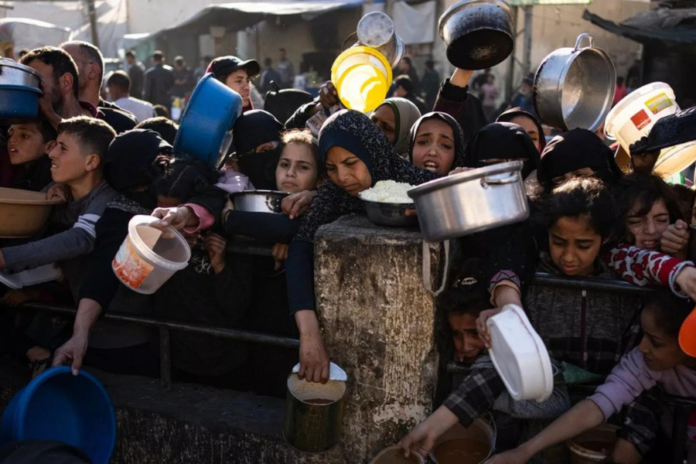Israel has been attacking Gaza for the past four months. Over 30,000 people have died in the enclave, thousands of them women and children. There is no more food or clean water in the most crowded area on Earth. It is now gazing at a famine.
According to a UN-backed report released on Monday, famine is about to strike northern Gaza, where 70% of the population is already experiencing catastrophic levels of hunger.
UN report on Gaza
Around 1.1 million people, or half the population, live in catastrophic food insecurity, according to a report by the Integrated Food Security Phase Classification (IPC), an initiative of over a dozen UN agencies, regional bodies, and aid organizations. This indicates that the entire population of Gaza is experiencing high levels of acute food shortage.
“Famine is now projected and imminent in the North Gaza and Gaza Governorates and is expected to become manifest during the projection period from mid-March 2024 to May 2024,” the UN report said.
In northern Gaza, acute hunger and malnutrition have already “far exceeded” the famine threshold, and the IPC has issued a warning about a “major acceleration of death and malnutrition.”
UN Secretary-General Antonio Guterres stated that this is the “highest number of people facing catastrophic hunger ever recorded… anywhere, anytime” according to the IPC.
According to the IPC assessment, starvation is predicted to break out if hostilities persist in obstructing the delivery of humanitarian aid to areas of Gaza where people live and if the battle intensifies, including the anticipated ground offensive in the southern city of Rafah.
The situation, it claimed, was “entirely manmade,” “preventable,” and resulted from Israel’s blockade of supplies and demolition of Gaza.
What is a famine?
According to the UN, famine occurs when a significant portion of the populace in a region lacks access to enough food, resulting in widespread malnutrition and the death of illness and starvation.
When there is a severe food insecurity, people’s life or means of subsistence are in jeopardy.
Also Read: Taliban warns Pakistan after airstrikes hit Afghanistan
The IPC evaluates the circumstances and determines whether a region should declare a famine based on a five-tier methodology. When the fifth rung is reached, a famine is officially declared. A “crisis” is a third tier and a “emergency” is the fourth.
One in three children must be severely malnourished, and at least 20% of the population must experience severe food shortages for the IPC to declare famine. and two out of every 10,000 individuals, or four out of every 10,000 children, every day succumbing to illness, famine, or malnourishment.
A person experiences malnutrition when they either consume too little food or too much of the wrong kind of food. If a person does not consume enough calories, starvation is a process that can result in death.
Situation in Gaza
The population of Gaza is 2.3 million. Approximately 1.1 million people living in the enclave are experiencing “catastrophic hunger.” That is two times the amount that was considered dangerous in December.
According to the IPC, malnutrition is most likely already reached famine levels. It calculated that people in Gaza would soon be dying at a pace comparable to a famine despite not having enough data on the country’s death rate. Children under four may already be, the UN agency claimed.
As per the Ministry of Health in Gaza, at least twenty-five individuals, including infants and children, have perished in the north due to malnutrition and dehydration.
In desperation, some have started eating grass and animal feed. Gazans are forced to drink contaminated water due to a shortage of clean water.
The population of Gaza require an estimated 500 trucks of food and supplies per day to meet their requirements. However, these supplies have decreased since the incident on October 7, which sparked the Israel-Hamas conflict.
According to the UN, the 300 trucks that entered Gaza on November 28 were the highest in a single day since the conflict began. In February, the enclave was breached in seven days by no more than twenty vehicles.
In recent weeks, Israel has been blocking the delivery of aid supplies including food to the strip. On Sunday, the first aid trucks entered northern Gaza in months.



